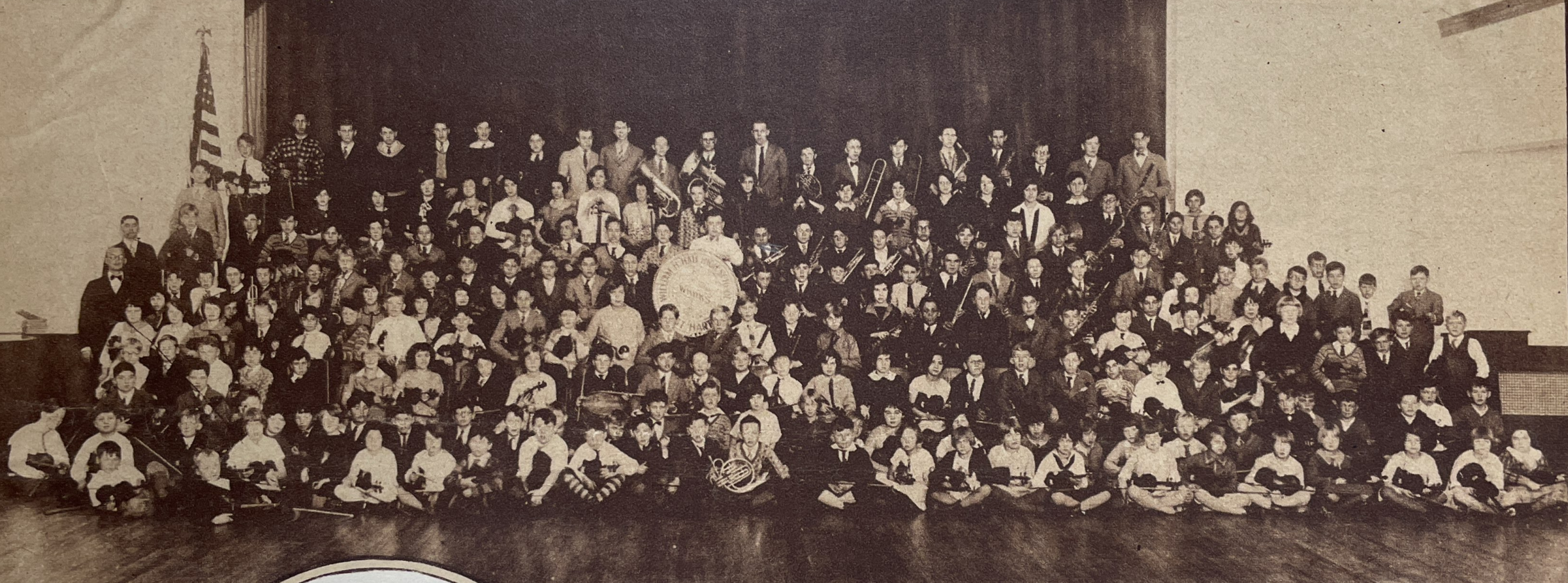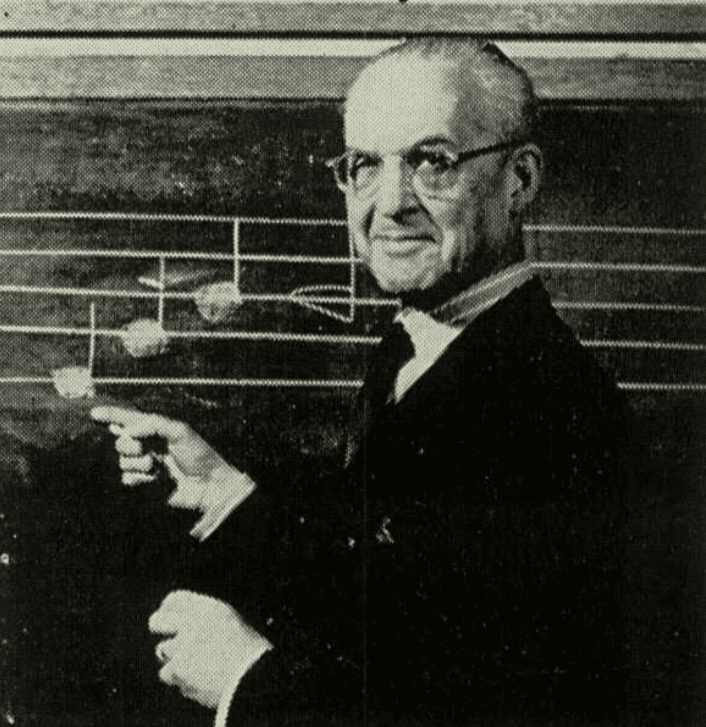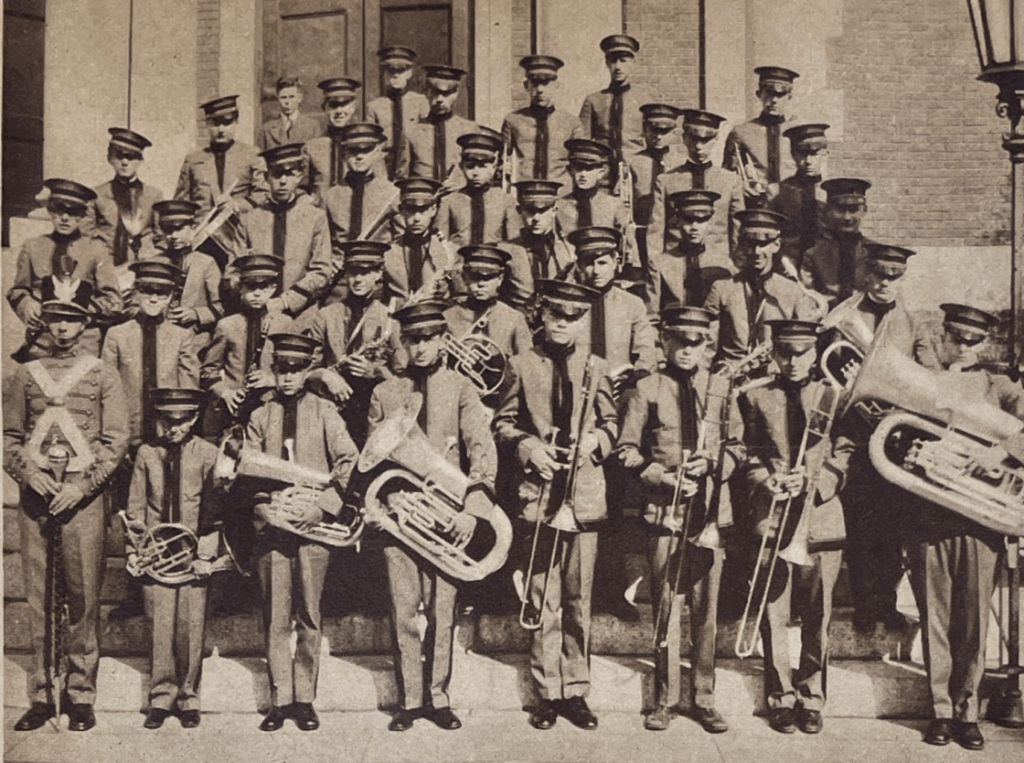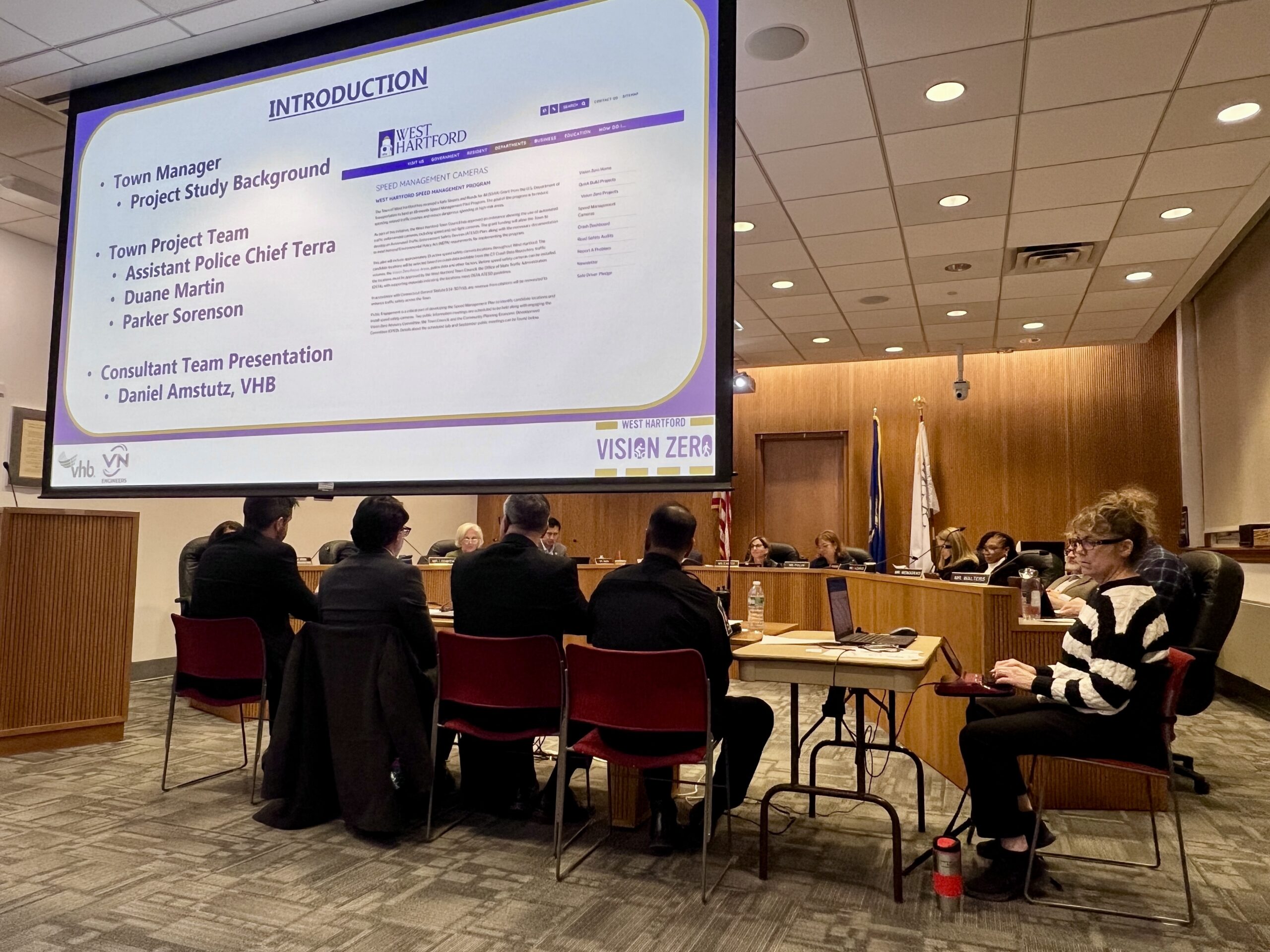From the West Hartford Archives: Music Students and Director Mark Davis

Audio By Carbonatix

West Hartford Public Schools music students in 1927. Photo courtesy of Noah Webster House & West Hartford Historical Society
Historian Jeff Murray takes a look into West Hartford’s past to uncover some surprising information, stir up some memories, or reflect on how much life has changed – or hasn’t changed at all. Enjoy this week’s ‘From West Hartford’s Archives’ …
By Jeff Murray
This photograph shows the pupils of West Hartford schools who were receiving free musical instruction as part of the regular curriculum at the beginning of 1927.
The Hartford Courant considered West Hartford “one of the first [towns] in the country to give free instrumental instruction integrated with the academic program from elementary school to Hall High School.” This development was pioneered by Mark A. Davis, who came to West Hartford from Greenfield, Massachusetts in 1925 and immediately transformed the cultural landscape in the schools.
Music was primarily a religious or extracurricular activity for many years prior, but the Progressive Era (roughly 1890s to the 1920s) emphasized integrating the idea of “teaching the masses” through music, a tool for moral and social development. Religious leaders had formed bands and choirs in places of worship. The high school had choirs and glee clubs (which I wrote about this past January), but these were social organizations that cultivated skill beyond the public school system’s curriculum. Community bands were not enough to generate enough consensus to bring the music to all the schoolchildren.
Mark Davis grew up in Vermont as a singer, being educated at Goddard seminary in Barre City. Newspaper articles from his hometown detail vocal solos and musical selections when he was there. After he graduated from the seminary in 1903, he spent five years studying voice culture under Andrew J. Phillips in Chicago before returning to Vermont to conduct a private studio for a short time.
He was a supervisor of music and physical culture in the schools of Pittsfield, New Hampshire for only a few months in 1910 before moving to Montague, Massachusetts, where he was appointed to the same position there. “Mr. Davis is a singer and vocal teacher of ability, and since coming to Pittsfield he has had many pupils, who have made rapid advancement under his efficient instruction,” reported the Barre Daily Times.
The idea of combining music and physical culture into a single position was not accidental. They were both viewed as disciplines of moral and social improvement. The cultivation of body, mind, and spirit together had roots in the idea of forming character, something that President Theodore Roosevelt had championed just a few years before. Davis’ first years teaching clearly showed an ambition for uniting pupils under a single musical roof.

Director Mark Davis in the 1944 Hall High School Yearbook
It’s important to understand though what his background brought to West Hartford when he finally came to this town.
The idea of studying voice culture in the first decade of the 1900s was more than just refinement of the voice; it developed the concept that the human voice could (and should) be trained for beauty and health. He would have studied breath control, diction, resonance, and anatomy, all tied with physical health.
He had moved from Vermont to Chicago, a hub of musical training in the United States at the turn of the century. His studies were about preparing to lead the culture through music and only through the schoolchildren could this culture be fully imparted. It’s also important to recognize that even though it may seem like I am applying more holistic reasoning to a person’s actions (some might say he was strictly teaching music rather than trying to consciously mold the next generation), his life and his decisions were shaped by the world he was born into and therefore his work was as much, if not more, of a reflection of the world around him.
He developed independent but full orchestras, bands, and choirs in the schools he directed. When he left Greenfield, Massachusetts after 12 years’ work as supervisor, the Springfield Daily Republican newspaper noted his legacy: “He will be greatly missed in the local schools, where he has done much to raise the standard of the music and particularly by the Public School band, of which he was director, and the school orchestras with whom he worked untiringly.”
Davis moved to West Hartford at the end of 1925 with his wife Clara and daughter Sybil and was named the head of the music department of Hall High School, as well as the junior high schools. He immediately announced his intent to form a band and an orchestra, which had never been organized here before.
During World War I, military bands were a major part of patriotic and morale efforts, but the post-World War I world saw an explosion of school bands nationwide as thousands of returning soldiers came back with a different perception, instrument manufacturers promoted their sets and instructional materials, and contests created a sense of civic pride and competition. Davis oversaw regular rehearsals in the Hall auditorium and planned for uniforms as a symbol of discipline and standardization. Whether he knew it or not, he was one of many musical directors in the 1920s that were adopting military-style organization in the music programs, mirroring the army bands of the recent war. Elementary school students applied for admission into the junior band, which would serve as preparation for the high school group.
No comprehensive music program in our schools would be complete without an orchestra. Two junior orchestras had been formed at Plant Junior High School and Seymour School (Smith School) under the direction of Davis’s assistant, Timothy Sheehan. The schools provided the larger bass horns and drums, but children generally brought their own instruments. Families purchasing their own instruments was still common before federal or district funding existed.
In the mid-1920s, when the orchestras were formed, the violin was by far the most popular instrument. This perhaps was simply just a product of time: the violin symbolized the high art and expertise of European classical culture, bringing to mind composers like Mendelssohn. Learning the violin (when the wealthy had their children taught) was similar to the study of Latin or elocution. European models of education also emphasized violin training as the foundational instrument for pitch, tone, and reading music. In a time when not every household had a piano, the violin was easier to maintain in a middle-class household, especially a growing suburb like West Hartford.
Director Davis joined this town at a transitional moment in musical instruction. Besides the violin, brass and woodwinds were becoming more accessible and the rise of popular culture (like radio, jazz, and swing) made band instruments modern and appealing. The violin still predominated in the orchestra, but band instruments were about to take over as tastes shifted.
In January 1927, the featured photograph was taken to highlight West Hartford’s musical program. It was one of the first towns, under Mark Davis, to adopt free instrumental instruction integrated with the curriculum. By this point, 300 students, boys and girls from the earliest grades, were being taught together in a schoolwide program.
Soon after, the Hall High School band made its first public appearance in a concert given as part of a program for the Parent-Teacher Association. They were came equipped with uniforms, making this band the first and only uniformed school band in the state of Connecticut. The former president of the West Hartford Chamber of Commerce and popular grocery store owner, Myron J. Burnham, presented the members their uniforms. They played at the Connecticut State Fair, followed by the Big-E in the fall of 1927. The band then played the Memorial Day parades and ceremonies for more than 20 years consecutively. Davis then set out on maturing the Hall Opera Club, which he directed until 1940.

“The Only Uniformed High School Band in Connecticut”, 1927. Photo courtesy of Noah Webster House & West Hartford Historical Society
Davis retired as director of music in West Hartford in the spring of 1948. His position was filled by Frank Groff of New Jersey. He died in 1963 at a local convalescent home. He was survived by his daughter Sybil, the wife of J. Howard Pease, as well as nieces and nephews.
Sybil was an elementary school teacher in Pittsfield, who left no descendants when she died in 1993. Her only surviving family members were a number of cousins living in Massachusetts. Her father was a pioneer in musical instruction in our schools in the early years and that legacy was carried through the marching bands and orchestras that accompanied town events to the current day.
His dedication was legendary and may be exemplified by this piece of history: in the summer of 1926, not a year into his residence in West Hartford, Davis’s house was destroyed by fire. All his clothes were burned, as well as other personal belongings. Thankfully, he was away from the house at the time, conducting a concert in the evening.
Jeff Murray was born and raised in West Hartford and has been involved with the Noah Webster House & West Hartford Historical Society since 2011 when he was a high school student and won the Meyer Prize for his essay on local history. Jeff routinely volunteers as local history researcher uncovering information for numerous museum programs such as the West Hartford House Tour and West Hartford Hauntings. Jeff works as a data analyst at Pratt & Whitney.
Like what you see here? Click here to subscribe to We-Ha’s newsletter so you’ll always be in the know about what’s happening in West Hartford! Click the blue button below to become a supporter of We-Ha.com and our efforts to continue producing quality journalism.



